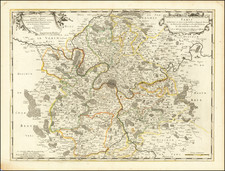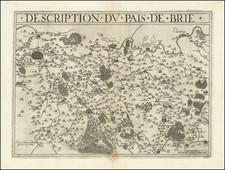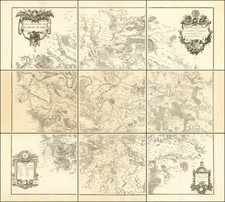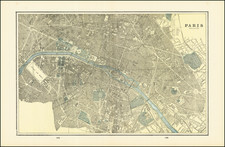Map of Europe's Most Well-Known Bouldering Region, by a Disciple of the Father of French Nature Tourism
Fantastic hiking map of the world's first nature preserve. This colorful map of Fontainebleau shows the large park, located just outside of Paris, crisscrossed by miles of hiking trails, with a great number of points of interest located.
Located just south of Paris, the nature preserve around Fontainebleau is built on the former estate of one of the greatest castles in Europe. Thanks to the efforts of Claude-François Denecourt, a former French soldier, the park was set aside for recreational use for public consumption. Starting in 1842, he developed hiking trails through the forest, which drew in crowds from all over Europe. In the period 1860-1862, he pushed hard for the park's preservation, culminating in a petition sent to the Emperor Napoleon III. This resulted in the park becoming a nature preserve, ten years before the establishment of the first national park in the US, Yellowstone.
As noted in Elaine Sciolino's The Invention of Hiking: Follow the Frenchman who remade the woods surrounding a royal estate into the world’s first nature preserve . . . (Smithsonian Magazine, May 2020)
Claude-François Denecourt was a career soldier in the French Army, but was dismissed from his post as concierge of a Fontainebleau barracks in 1832 because of his supposed liberal views. He took to wandering in the forest to combat his depression and there discovered the essential pleasures of traipsing through nature. From then on, he devoted himself to developing and promoting the Fontainebleau forest for the general public. Today he should be recognized and appreciated as both a clever entrepreneur and a pioneer—if not the inventor—of nature tourism.
This map was made by a disciple of Denecourt, Charles Colinet, who was responsible for undertaking many works to improve the park. He was responsible for building a number of bridges and waterworks within the park, and trails in the park are named "Denecourt-Colinet" paths, in honor of the two men.
The map is highly detailed, with block-level detail in cities. An inset shows train connections from Paris. A number of places of interest are listed, and a decorative border is included.











![[ Paris - Place du Roi de Rome - Place de Trocadero ]](https://storage.googleapis.com/raremaps/img/small/90032.jpg)


![[ Paris Wall Map ] Plan Geometral de Paris a L'Echelle de 0.001 pour 10 Metres ( 1/100,000)](https://storage.googleapis.com/raremaps/img/small/97781.jpg)